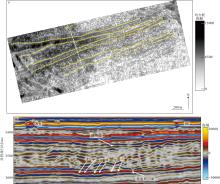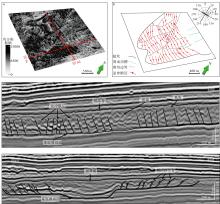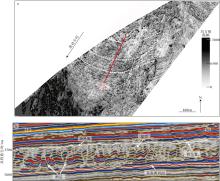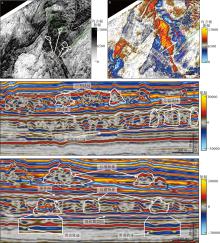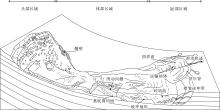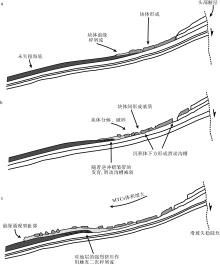Journal of Tropical Oceanography ›› 2025, Vol. 44 ›› Issue (5): 108-124.doi: 10.11978/2024233CSTR: 32234.14.2024233
• Marine Geology • Previous Articles Next Articles
Identification and analysis of kinematic indicators of early pliocene mass transport complexes: A case study of the northeastern continental slope in the Qiongdongnan Basin*
JU Zelong1,2( ), ZHAN Wenhuan1,2(
), ZHAN Wenhuan1,2( ), GUO Jian3, WU Xiaochuan4,5, LI Jian1, YAO Yantao1, FENG Yingci1, SUN Jie1, WANG Pin1, YI Hu1,2, HUANG Jiaxian1,2, XIONG Xin6
), GUO Jian3, WU Xiaochuan4,5, LI Jian1, YAO Yantao1, FENG Yingci1, SUN Jie1, WANG Pin1, YI Hu1,2, HUANG Jiaxian1,2, XIONG Xin6
- 1. CAS Key Laboratory of Ocean and Marginal Sea Geology (South China Sea Institute of Oceanology, Chinese Academy of Sciences), Guangzhou 511458, China
2. University of Chinese Academy of Sciences, Beijing 100049, China
3. Shandong Provincial Geo-mineral Engineering Exploration Institute (801 Institute of Hydrogeology and Engineering Geology, Shandong Provincial Bureau of Geology and Mineral Resources), Jinan 250014, China
4. National Joint Local Engineering Research Center for Shale Gas Exploration and Development, Chongqing Institute of Geology and Mineral Resources, Chongqing 401120, China
5. Key Laboratory of Shale Gas Exploration, Ministry of Natural Resources, Chongqing Institute of Geology and Mineral Resources, Chongqing 401120, China
6. School of Surveying and Geoinformation Engineering, East China University of Technology, Nanchang 330013, China
-
Received:2024-12-13Revised:2025-02-21Online:2025-09-10Published:2025-10-14 -
Contact:ZHAN Wenhuan -
Supported by:Major Talent Project in Guangdong Province(2023JC07H110); National key Research and Development Program of China(2022YFC3103800); National Natural Science Foundation of China(42206069); National Natural Science Foundation of China(42272098); Science and Technology Projects of Guangzhou(2023A04J0191); Hainan Provincial Natural Science Foundation of China(423QN321)
CLC Number:
- P736.121
Cite this article
JU Zelong, ZHAN Wenhuan, GUO Jian, WU Xiaochuan, LI Jian, YAO Yantao, FENG Yingci, SUN Jie, WANG Pin, YI Hu, HUANG Jiaxian, XIONG Xin. Identification and analysis of kinematic indicators of early pliocene mass transport complexes: A case study of the northeastern continental slope in the Qiongdongnan Basin*[J].Journal of Tropical Oceanography, 2025, 44(5): 108-124.
share this article
Add to citation manager EndNote|Reference Manager|ProCite|BibTeX|RefWorks
Tab. 1
Kinematic indicators and seismic facies characteristics of MTCs development in each stage"
| MTCs | 类型 | 时代 | 平均厚度/m | 运动标志 | 地震相特征 | |
|---|---|---|---|---|---|---|
| MTC4 | 含块体 | 上新世 | 130 | 挤压脊、块体和滑动轨迹 | 中−强振幅, 杂乱反射, 块体内部表现为杂乱、 透明反射特征 | |
| MTC3 | 含块体 | 上新世 | 200 | 挤压脊、沟槽、块体、 滑动轨迹和逆冲褶皱带 | 中−强振幅, 杂乱反射, 块体内部表现为强振幅平行、 倾斜堆叠反射特征 | |
| MTC2 | 不含块体 | 早中新世 | 150 | 挤压脊 | 弱振幅, 高连续性, 水平状 | |
| MTC1 | 不含块体 | 早中新世 | 140 | 挤压脊 | 弱振幅, 半透明, 杂乱反射 | |
| [1] |
白博, 秦志亮, 杨鲲, 等, 2016. 珠江口盆地白云深水区海底重力滑脱构造地震地质综合识别[J]. 物探化探计算技术, 38(2): 219-224.
|
|
|
|
| [2] |
蔡佳, 2017. 琼东南盆地长昌凹陷新近系三亚组沉积相[J]. 岩性油气藏, 29(5): 46-54.
|
|
|
|
| [3] |
杜浩, 石万忠, 梁金强, 等, 2021. 琼东南盆地块体搬运沉积体系成因及其对水合物成藏的影响[J]. 石油地球物理勘探, 56(4): 869-881, 676.
|
|
|
|
| [4] |
冯杨伟, 屈红军, 张功成, 等, 2016. 南海北部琼东南盆地深水区梅山组一段地震相分析[J]. 矿物岩石, 36(1): 82-95.
|
|
|
|
| [5] |
付超, 于兴河, 金丽娜, 等, 2017. 琼东南盆地莺歌海组重力流沉积演化过程[J]. 沉积学报, 35(3): 552-560.
|
|
|
|
| [6] |
何云龙, 解习农, 李俊良, 等, 2013. 琼东南盆地东西部块体流沉积内部结构特征的差异性[J]. 吉林大学学报(地球科学版), 43(1): 49-56.
|
|
|
|
| [7] |
胡守祥, 姚衍桃, 李健, 等, 2021. 琼东南盆地陆架区晚中新世以来断层活动性研究[J]. 热带海洋学报, 40(2): 90-102.
|
|
|
|
| [8] |
雷超, 任建业, 裴健翔, 等, 2022. 莺歌海-琼东南盆地结合部记录的红河断裂带向海延伸及其演化过程[J]. 中国科学: 地球科学, 52(1): 81-97.
|
|
|
|
| [9] |
雷亚妮, 王广建, 吴时国, 2018. 白云凹陷深水油气开发区海底滑坡的特征、分布以及成因初探[J]. 海洋地质与第四纪地质, 38(2): 106-114.
|
|
|
|
| [10] |
李杰, 林畅松, 陈平富, 1999. 琼东南盆地莺歌海组-黄流组海平面变化与层序年代地层[J]. 地质论评, 45(5): 514-520.
|
|
|
|
| [11] |
李铁刚, 曹奇原, 李安春, 等, 2003. 从源到汇: 大陆边缘的沉积作用[J]. 地球科学进展, 18(5): 713-721.
|
|
|
|
| [12] |
李伟, 吴时国, 王秀娟, 等, 2013. 琼东南盆地中央峡谷上新统块体搬运沉积体系地震特征及其分布[J]. 海洋地质与第四纪地质, 33(2): 9-15.
|
|
|
|
| [13] |
李艳, 2022. 大陆边缘块体搬运沉积体系的地震响应及运动学过程分析[D]. 广州: 中国科学院南海海洋研究所.
|
|
|
|
| [14] |
李艳, 吴南, 胡守祥, 等, 2021. 南海白云凹陷东南部两种不同类型块体搬运沉积体系的地震响应及成因分析[J]. 热带海洋学报, 40(5): 85-100.
|
|
|
|
| [15] |
罗泉源, 焦祥燕, 何小胡, 等, 2023. 琼东南盆地西区黄流组重力流水道沉积特征及其控制因素[J]. 海洋地质前沿, 39(7): 25-33.
|
|
|
|
| [16] |
马畅, 葛家旺, 赵晓明, 等, 2022. 南海北部琼东南盆地第四系陆架边缘轨迹迁移及深水沉积模式[J]. 地学前缘, 29(4): 55-72.
|
|
|
|
| [17] |
马宏霞, 吕福亮, 范国章, 等, 2011. 缅甸若开海域块体搬运沉积地震响应及典型地质特征[J]. 石油与天然气地质, 32(5): 751-759.
|
|
|
|
| [18] |
马云, 李三忠, 梁金强, 等, 2012. 南海北部琼东南盆地海底滑坡特征及其成因机制[J]. 吉林大学学报(地球科学版), 42(S3): 196-205.
|
|
|
|
| [19] |
孟苗苗, 阎少妮, 梁金强, 等, 2024. 琼东南盆地块体搬运体系沉积特征及其对下伏水合物藏的影响[J]. 地质学报, 98(9): 2592-2606.
|
|
|
|
| [20] |
孙珍, 钟志洪, 周蒂, 等, 2003. 红河断裂带的新生代变形机制及莺歌海盆地的实验证据[J]. 热带海洋学报, 22(2): 1-9.
|
|
|
|
| [21] |
王大伟, 吴时国, 董冬冬, 等, 2009. 琼东南盆地第四纪块体搬运体系的地震特征[J]. 海洋地质与第四纪地质, 29(3): 69-74.
|
|
|
|
| [22] |
王大伟, 吴时国, 吕福亮, 等, 2011. 南海深水块体搬运沉积体系及其油气勘探意义[J]. 中国石油大学学报(自然科学版), 35(5): 14-19.
|
|
|
|
| [23] |
谢金有, 祝幼华, 李绪深, 等, 2012. 南海北部大陆架莺琼盆地新生代海平面变化[J]. 海相油气地质, 17(1): 49-58.
|
|
|
|
| [24] |
闫琢玉, 李建平, 龚胜利, 等, 2023. 琼东南盆地北部梅山组浊积扇砂组构特征与物源体系差异[J]. 天然气地球科学, 34(12): 2087-2100.
|
|
|
|
| [25] |
杨胜雄, 邱燕, 朱本铎, 2015. 南海地质地球物理图系[M]. 天津: 中国航海图书出版社.
|
|
|
|
| [26] |
袁玉松, 杨树春, 胡圣标, 等, 2008. 琼东南盆地构造沉降史及其主控因素[J]. 地球物理学报, 51(2): 376-383.
|
|
|
|
| [27] |
钟佳, 杨希冰, 朱沛苑, 等, 2019. 琼东南盆地宝岛-长昌凹陷陵水组储层差异演化特征[J]. 地球科学, 44(8): 2665-2676.
|
|
|
|
| [28] |
|
| [29] |
|
| [30] |
|
| [31] |
|
| [32] |
|
| [33] |
|
| [34] |
|
| [35] |
|
| [36] |
|
| [37] |
|
| [38] |
|
| [39] |
|
| [40] |
|
| [41] |
|
| [42] |
|
| [43] |
|
| [44] |
|
| [45] |
|
| [46] |
|
| [47] |
|
| [48] |
|
| [49] |
|
| [50] |
|
| [51] |
|
| [52] |
|
| [53] |
|
| [54] |
|
| [55] |
|
| [56] |
|
| [57] |
|
| [58] |
|
| [59] |
|
| [60] |
|
| [61] |
|
| [62] |
|
| [63] |
|
| [64] |
|
| [65] |
|
| [66] |
|
| [67] |
|
| [68] |
|
| [69] |
|
| [70] |
|
| [71] |
|
| [1] | SONG Ruiyou, MA Guangke, HE Xiaohu, WAN Yang, HE Liwen. Structural-sedimentary characteristics and oil and gas exploration potential of Yabei sag of the Qiongdongnan Basin [J]. Journal of Tropical Oceanography, 2024, 43(5): 93-105. |
| [2] | ZHAO Zhongxian, SUN Zhen, MAO Yunhua, ZHANG Huodai. Heterogeneous extension and pulsed tectonic subsidence in the northern South China Sea margin* [J]. Journal of Tropical Oceanography, 2023, 42(3): 96-115. |
| [3] | HU Shouxiang, YAO Yantao, LI Jian, LI Shuang, WANG Ling, ZHAN Wenhuan, LI Wei, FENG Yingci. Study on fault activities since the Late Miocene in the continental shelf of Qiongdongnan Basin [J]. Journal of Tropical Oceanography, 2021, 40(2): 90-102. |
| [4] | Tiantian SUN, Daidai WU, Mengdi PAN, Fei YANG, Nengyou WU, Xuegang CHENG, Lihua LIU. Geochemical characteristics of surface sediments in the Southern Qiongdongnan Basin of the northern South China Sea and its implication for sedimentary environment* [J]. Journal of Tropical Oceanography, 2018, 37(4): 70-80. |
| [5] | HE Yong,SU Zheng,WU Neng-you,. Effect of nonhydrocarbon gas on thickness of hydrate stability zone under deep water in Qiongdongnan Basin [J]. Journal of Tropical Oceanography, 2012, 31(5): 62-69. |
| [6] | XU Zi-ying, SUN Zhen*, ZHOU Di, ZHANG Yun-fan, SUN Long-tao, ZHAO Zhong-xian. Discussion on the influence of weakness body on inversion structure deformation through analogue modeling and its application [J]. Journal of Tropical Oceanography, 2012, 31(3): 144-154. |
| [7] | LI Ya-min,SHI Xiao-bin,XU Hui-long,LIU Bing. Analysis on the characteristics of Paleogene basement faults’ activity in Qiongdongnan Basin [J]. Journal of Tropical Oceanography, 2011, 30(6): 74-83. |
|
||










